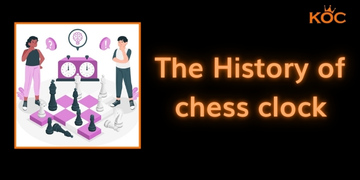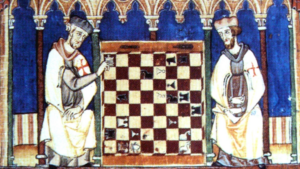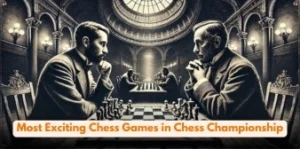Did you ever play a game of chess in which your opponent took ages to make a move? It can be annoying, isn’t it? Chess is a game of strategy and skill, but if there is no time limit, some players might take forever to think. This makes the game slow and boring.
That’s where a chess clock comes in handy! A chess clock makes sure both players receive the same time to play. There are many uses of chess clock– it keeps the game fair, quick, and fun. Either way you’re playing, a chess clock enhances your decision-making and time-management abilities.
At Kingdom of Chess, we lay special stress on the importance of chess clocks in modern chess. Through our training programs, players learn to employ various types of clocks and gain expertise in handling multiple timing styles in order to improve their gameplay.
What is a Chess Clock and How Does It Work?
A chess clock is a machine that contains two timers, one for each player. When a player makes a move and pushes the clock, their timer is halted and the other player’s timer is activated. This cycle is repeated throughout the game until one of the players is out of time or the game is finished due to checkmate, draw, or resignation.
Major Features of a Chess Clock:
- Two individual timers – One for both players.
- Pressing mechanism – Stops one clock and activates the other.
- Time controls – Players have a limited amount of time for the entire game or chess rule time per move.
- Penalty for running out of time – If a player runs out of time, they lose the game unless the opponent has insufficient material to checkmate.
Playing with a chess clock habituates the players to think quickly and logically, an essential skill in tournament chess.
Types of Chess Clocks
Over time, chess clocks have become more complex from simple mechanical clocks to sophisticated digital clocks. The following are the principal types of chess clocks:
1. Analog Chess Clocks
- Old-fashioned mechanical clocks with clock hands.
- A small flag falls when a player’s time expires.
- Increments and delays cannot be added.
- Not as accurate as digital clocks.
2. Digital Chess Clocks
- Digitally displays time with accurate precision.
- Increments and delays can be set.
- Used in nearly all contemporary tournaments.
At Kingdom of Chess, we teach players to employ both types so that they are able to play in any environment, be it casual or competitive.
What’s the Difference Between Bronstein Delay and Simple Delay?
Delays prevent players from losing on time unfairly. The two most popular delay methods are:
1. Simple Delay
- A fixed time (e.g., 5 seconds) is provided before the main time begins counting down.
- If a player moves inside this delay period, their base time is unaffected.
2. Bronstein Delay
- The same as Simple Delay but only subtracts actual time spent.
- If a player has 5-second Bronstein delay and moves in 3 seconds, 3 seconds are subtracted from their base time.
Understanding these timing styles enables players to control their time well in a game.
What is Sudden Death Time Control?
Sudden Death Time Control refers to giving each player a set amount of time for the whole game. As soon as a player’s time expires, they lose.
Standard Sudden Death Time Controls:
- Blitz – 3 to 5 minutes per player.
- Rapid – 15 to 60 minutes per player.
- Classical – 90 minutes or more per player.
Sudden Death formats impose time pressure and necessitate rapid thought. Our chess instruction at Kingdom of Chess educates students in coping with such time controls and playing under pressure.
Why Digital Chess Clocks Replaced the Old Analog Ones
Digital chess clocks have become the norm in competitive chess. Here’s why they are used:
- More accuracy – Digital clocks are accurate in measuring time.
- Custom time controls – You can specify increments, delays, and alternative timing formats.
- Improved visibility – Players know the precise amount of time left.
Although a few chess players prefer the old-fashioned look of analog clocks, digital clocks are more convenient and commonly used during tournaments.
How Chess Clocks Transformed Modern Chess
The invention of chess clocks transformed the game. There are many advantages of chess clock-
1. Fair Play
No longer do players take unnecessary time—both players are required to play within the allocated time.
2. Strategic Thinking
Players have to use their time effectively, maintaining speed while ensuring accuracy.
3. Quicker Game Formats
Blitz and Rapid formats have gained popularity with the advent of chess clocks.
FAQ's
What is the clock rule in chess?
The chess clock rule is that every move by each player must be completed within their allocated time. If a player is out of time before checkmate, they lose the game unless their opponent can’t checkmate with the pieces left on the board.
What happens with time during a chess tournament?
There are various time controls used in tournaments, some rules of timing are:
- Classical – 90 minutes + 30-second increment per move.
- Rapid – 15-60 minutes for each player.
- Blitz – 3-5 minutes for each player.
We teach our students to work with various time formats so they are able to compete with confidence.
What chess clock is employed in tournaments?
Digital clocks such as the DGT 3000 and Chronos GX are used in most tournaments. These clocks have features such as increments and delay settings, which are necessary for equitable gameplay.
What is the clock notation in chess?
Clock notation records the time taken for each move. Example:
- 1.e4 (1:15) – White played 1.e4 with 1 minute 15 seconds remaining.
- 1…c5 (1:30) – Black played 1…c5 with 1 minute 30 seconds remaining.
Understanding clock notation helps players track their time and improve their time management skills.
What is the increment clock in chess?
An increment clock provides additional seconds after each move.
- Example: In a 5-minute game with an increment of 5 seconds, 5 seconds are added to the player’s time after each move.
This avoids players losing simply because of time trouble.
Who Invented the First Digital Chess Clock & Its Early Problems?
Bruce Cheney, a student at Cornell University, created the first digital chess clock in 1973. Though it offered increased precision, even the early devices suffered from failure of batteries and display malfunction. With time, the technology became better, and digital clocks became more dependable.
- Click here to use an online chess clock for your friendly match.
Conclusion
Chess clocks have been instrumental in making chess equitable, stimulating, and competitive. As a beginner or an experienced player, knowing how to use a chess clock is very important.
At Kingdom of Chess, we educate players how to operate a variety of types of chess clocks, become adept at time controls, and exercise effective time management.
Improve your chess capabilities and time management! Enroll in our training programs today and enhance your gameplay to the next level!
Also Read: How to Improve Your Chess Skills with Online Chess Lessons






